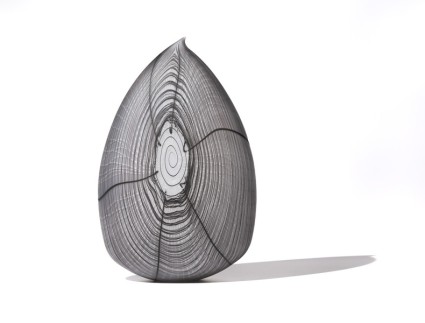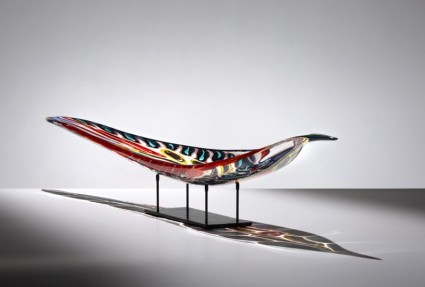In the contemporary art glass world, a personal connection can make all the difference.
“When we have a collectors’ event, the artists who attend and make personal connections with people tend to sell really well,” says Kenn Holsten of Holsten Galleries.
“This is natural because when you get to know someone and understand how they make their art and why they make their art and what their thinking was, you start seeing the object in a totally different way, in a much more enlightened and informed way.”
Holsten is well-poised to make such a statement. In the past three decades he has watched contemporary glass art in America grow from infancy into young adulthood. In fact, Holsten Galleries nestled in the arts mecca of Stockbridge Massachusetts, was one of the first galleries in the United States to show contemporary art glass.
Holsten currently represents thirty glass artists, and is quick to point out that the list includes such well-known artists as Dale Chihuly, Lino Tagliapietra and William Morris.
“It was our first show in 1981 with Harvey Littleton, which launched us as a glass gallery of note,” says Holsten. Littleton is well known today as the father of the American studio glass movement. That show took place at Holsten’s gallery on Worth Avenue in Palm Beach, his first glass gallery in Florida.
“Because of that success we got the attention of Dale Chihuly and some of the other best and most important glass artists of the early eighties. That gave us entree to the other artists and to be taken seriously as a glass gallery.”
Over the years, Holsten has witnessed a huge transformation in the quality of art, the audience and the business of gallery ownership. He describes an interwoven community that includes glass artists, collectors and galleries.
“I think that’s unique in the art world,” he says. “A network has formed by itself. This started in the mid eighties and has consolidated and grown since then.”
“Glass collectors to me seem to be somewhat unique in that they visit each other, travel together, and share in the celebration of recent acquisitions.”
This has been a tremendous benefit to contemporary glass galleries such as Holsten Galleries, which is constantly striving to promote glass artists and increase its clientele.
Not surprisingly, the internet has aided that growth. However, Holsten says his 2,000 square foot gallery is still a major part of the business, accounting for a least 50 percent of all sales. Holsten also participates in major yearly art shows in Chicago, New York, Los Angeles and Palm Beach. These shows account for some 25 percent of the gallery’s income.
Space is an issue for the gallery, which is housed alongside a dentist, a wine seller and a bank in a seventies-style building on Stockbridge’s Elm Street. The gallery was originally only 1,000 square feet and has expanded three different times, as space became available over the past thirty years. The gallery currently boasts three upstairs areas and an atrium space, where a Chihuly chandelier hangs boldly. Bulging with more art than it can show, Holsten says the business has to wait for another neighbor to vacate in order to have any further expansion.
“We like where we are and we don’t want to move. We’re in one of the prettiest and busiest towns in New England,” he says. “We would like to have more space to be able to show more up-and-coming artists – that’s something that we really miss.”
Holsten says because of the space issue, the gallery only takes on one or two new artists a year and even then, those artists are often already well established.
“Holsten Galleries is a little bit different than other galleries. Even though we show thirty artists, we tend to focus on a handful of the top artists in the country as opposed to having a one-person show each month all year long,” he says. Instead, Holsten Galleries always has a grouping of work from every artist they represent on display. “On the other hand, whereas most of the other galleries tend to show a mix of many artists’ work at the big shows such as SOFA-Chicago or SOFA-New York, we prefer to present major one-person exhibitions of only one or two artists at those shows. It has always worked well for us to do it this way.”
Holsten says there are a number of qualities he looks for in considering a piece for his gallery: originality, craftsmanship, and beauty.
“First of all it has to be well-made. It has to have a very, very high level of craftsmanship,” he says. “It also needs to be original or at least somewhat original – a new idea. It can’t look like someone else that we already show. You can say that every artist is influenced by other artists, and influence is ok, but copying is not.”
Holsten says most of the work the gallery shows has a degree of beauty to it – classic beauty, he clarifies. Beauty is in the eye of the beholder and in this case, “the eyes are our eyes”, and fittingly so. He is, after all, presenting art for his clients, whom he knows very well. Holsten credits art director Jim Schantz, who has been with Holsten for 25 years, for being the eyes of the gallery. “He’s the reason everything looks so good,” he says.
“There’s a lot of work being done in contemporary glass which doesn’t even have any intention to be beautiful or any reference to beauty in a traditional sense. It may be making a social or political statement. We tend to show work in our gallery which has some sort of classic beauty to it.”
“But that is not to say that we do not show some work which is in some way narrative or thought provoking. Some examples of this would be the works of William Morris, Preston Singletary or Charles Miner – but there is still some inherent beauty there, even if that beauty is more mythical or archetypal.”
Another consideration is how the piece will fit into the aesthetics of Holsten Galleries. “We have to consider, how the collectors are going to respond to this,” he says. “There may be work that we love, but that we don’t feel is a good match for our clientele or does not show well with the other art on display.”
Holsten says most art glass collectors are looking for pieces that excite them, and that can be quite subjective.
“In general people aren’t collecting a piece simply because the artist is so �important’. Rather people are looking for something that is uplifting, inspiring or makes them feel happy or that they have some sort of personal connection with.”
“There are a fair number of collectors who strongly prefer to collect the works of artists that they know or that they have at least met and spoken with. The personal connection is often really, really important.”
Holsten says glass has an inherent appeal advantage over opaque media because of the transparency and the way that light plays on the surface – the refraction and reflection. “There’s something kind of magical about glass. Contemporary glass has an immediacy about it. It is very approachable and generally most people can relate to it in a positive way.”
With contemporary painting galleries, some people walk in and can feel that they don’t “get it”. Holsten says, “Although there is a lot of glass art that engages one intellectually, politically or socially or makes a statement, you don’t always have to have that with glass. It can sometimes just be art for art’s sake. It makes people feel something – happy, uplifted. It can cause some sort of visceral reaction that is independent of critical judgment and I think that is one of the reasons that glass art is enjoying quite a bit of success in the contemporary art market.”
Holsten’s gallery celebrated its thirty-year anniversary last June and he says the glass market is stronger than ever.
One challenge for the industry is developing the market in terms of younger collectors. “Many of the major collectors in this country are people who have been collecting for twenty years or more, and they are getting older. They may be full or downsizing their collection as they move into smaller spaces. We do have younger clients, but they’re not as common. I would like to see more people in their thirties, forties, and fifties take up glass collecting.”
Holsten reflected on how art glass has changed from when he first opened his gallery doors with his first wife, Chandra, to having a satellite gallery for a decade in Palm Beach. “In the late seventies, glass was for the most part, functional blown glass – vases, stemware, paperweights and very early examples of glass sculpture. It tended to be not nearly so sophisticated as it is today – either stylistically or technically,” he says.
“Today there’s a real diversification of technique: casting, slumping, fabrication, blowing, or a mixture of those techniques. And then also mixed media, combining glass with stone, metal or wood.”
“It has been exciting and fulfilling to be part of the tremendous evolution of the studio glass movement over the past three decades. I look forward to seeing where that evolution will take all of us in the future!”
Copyright 2009. Reprinted with permission.


